11 of the most insane automotive interiors, by decade
I recently asked those in the Hagerty Community about the most insane interior they’ve ever seen. (You should visit our Community lounge, and not just because I’m the moderator.) Our users clearly did a great job, as their hard work motivated me to research this list of amazing automobile interiors. It was a collaborative labor of love amongst many of you, but I also dug up a few of my historical favorites. So let’s start from the early days of motoring and take a quick tour of 11 wild automotive interiors over the decades.
1901–07 Curved Dash Oldsmobile (Model R)
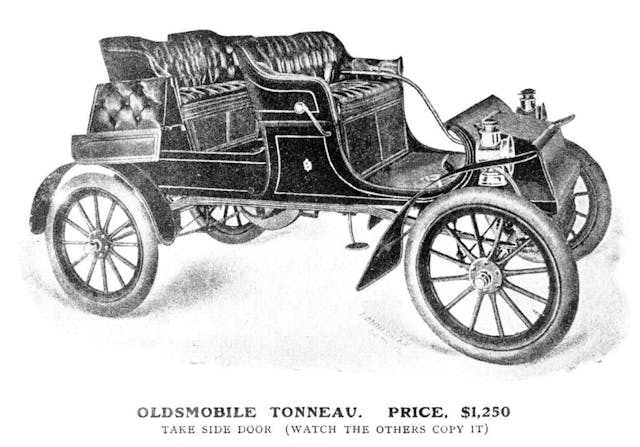
While it’s true that the first mass-produced car didn’t have much of an interior, what made this Oldsmobile unique for its time was the dashboard. Sure, that area looks like the front of Santa’s stereotypical sleigh, but that aggressive curve extends deep into the front passenger compartment. The Olds Tonneau body style has a nicely designed rear passenger section, complete with a shockingly well-padded rear door that, apparently, Oldsmobile was simply begging others to replicate. Perhaps this “Curved Dash” Olds is more than a configuration that protects occupants from “dashed up” (i.e. kicked up) debris from the spinning wheels—it might just be the first car with an interior designed for style and functionality.
1906–26 Rolls-Royce 40/50 Silver Ghost Limousine

Fully enclosed passenger compartments flourished in the nineteen-teens, and the more expensive brands obviously sported the most impressive interiors. This Silver Ghost from 1915 wears coachwork by H.A. Hamshaw with an interior worthy of an industrial magnate’s Pullman train car. Behold this Roller’s exquisite fabrics, overstuffed seats, retractable sunshades, wooden pull-out tray, decadent headliner, and exquisite door pulls. Combine the Pullman passenger experience with the durable and prestigious engineering of the Rolls Royce 40/50 chassis, and this car was likely one of the most expensive and beautiful ways to tour the countryside.
1922 Hispano-Suiza H6 Landaulet

There’s something about the Roaring Twenties and the landaulet body configuration that makes a perfect pairing. This Hispano-Suiza landaulet was crafted by Henri Chapron, and utilized the unique look of a roofless driver’s compartment plus an enclosed passenger compartment, with a folding top in place of a traditional C-pillar. This silhouette accommodated an interior made of wood door panels worthy of a high-end dining table, understated blue seat fabric with white-gray flecks, a rather revolutionary fold-down center arm rest, and a throughly conventional tuck-and-roll headliner … that became a theatrical thriller when you folded the C-pillar into the body. While there have been landaulet reboots in recent memory (Maybach, Lexus LS600h) there’s nothing quite the original ’20s execution.
1934 Voisin Type C27 Aérosport Coupe
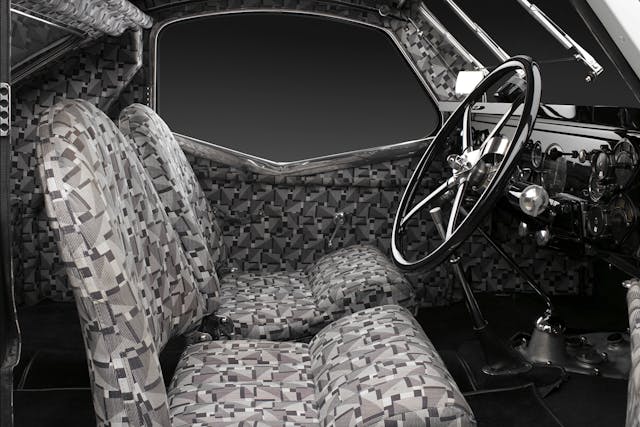
Art Deco was an era of visual arts that joined geometry with wide-ranging, international style/color palettes across many forms of industries. One such outlet was in French textiles, which could be why the automaker Voisin chose the radical material seen here for the interior upholstery of this C27 Aérosport Coupe. While it’s clear that Voisin’s aeronautic background influenced the vehicles that bore his name, the interior fabric selections were just as modern, perhaps even cutting-edge for the Interwar period.
1947–48 Tucker 48 (Torpedo)

The Tucker 48, or “Torpedo,” was a star-crossed vehicle in its heyday but a flat-out winner in today’s classic car market. Speaking of flat, that perfectly level floor—courtesy of its rear-mounted engine and electro-vacuum-operated transaxle—allowed Tucker to accomodate a radical interior. The sheer width of the car was so equally distributed that both rows of bench seating could use interchangeable cushions.
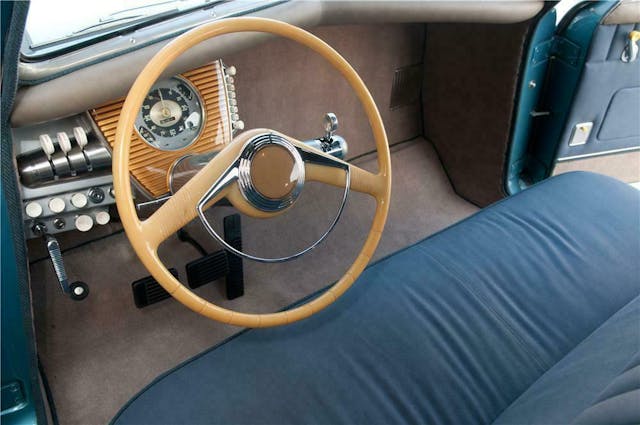
The featureless, open-air passenger-side dashboard was reminiscent of the Curved Dash Olds, as the glovebox was relocated to the right-hand-side door. Postwar automobile production was less about radical design and more about kickstarting a dormant supply chain, but the Tucker proved that innovation was still possible at the time … both outside and inside.
1959 Pontiac Bonneville
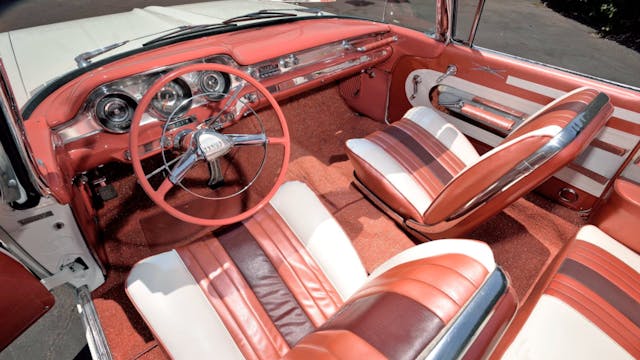
Car interiors of the 1950s were boldly optimistic in their color palette, liberal use of chrome, and space-age details. There are plenty of winners, especially when trimmed out in optional two-tone materials to match the radical exteriors of that era. But what about three-tone interiors—fashioned out of leather, no less? Pontiac embraced the tri-tone interior treatment on its flagship Bonneville, and the notion continued until the Bonneville Brougham of the late ’70s.

That’s some lasting power! How many other brands stuck with an interior conceit for that long?
1964 Ford Thunderbird
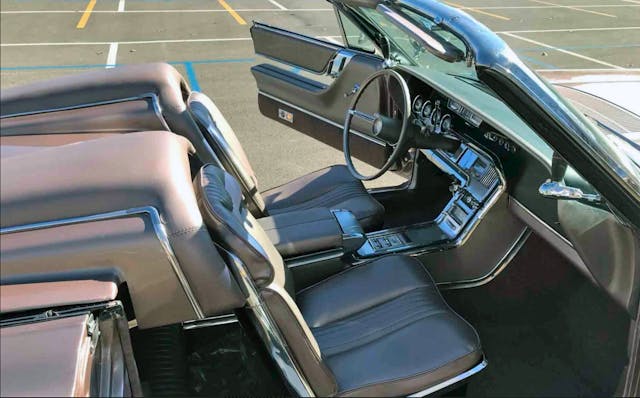
All Thunderbirds from this era sported dramatic, elegant interiors. They sported some of the finest materials available before safety, weight, cost, etc. forced metal to make way for plastic paneling. This 1964 model sported a swing-away steering wheel that moved to the right when parked for easier entry/egress. The dash effortlessly flowed into the console while the door panels aped the same “fast” contours. While the four-passenger cockpit was flowing and futuristic for all occupants, there was even an optional tonneau cover to hide the rear passenger section and yield an even racier appearance. The 2002 Thunderbird reboot tried to embrace this style, but the sheer volume of plastic parts recycled from other Ford products meant this ‘bird would never fly quite as high as its ’60s predecessor.
1975 Cadillac Sedan deVille
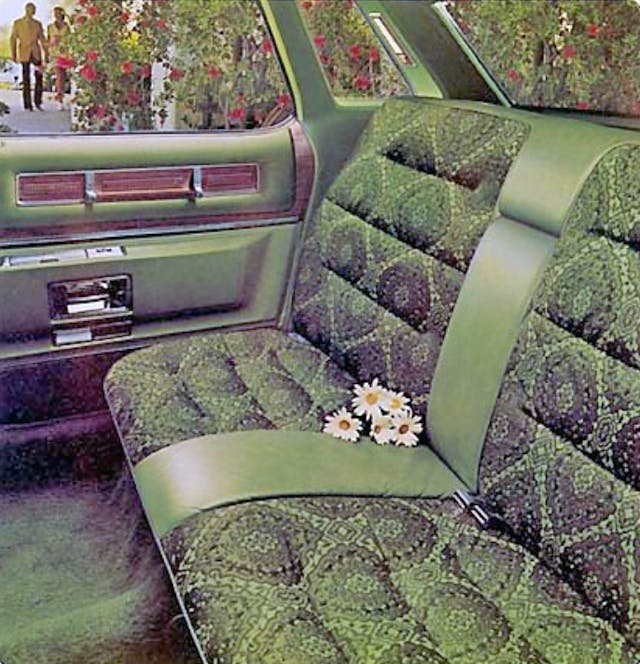
There are so many great interiors from the rapidly evolving 1970s—the affordable modernism of a Renault 5, the Pasha fabrics in Porsches, or anything done to lend swagger to the Malaise Era in Detroit. Everyone was a winner, though there may have been more winning in the 1975 Cadillac lineup, as it was a good year for fans of wild and brash materials. There’s “Maharajah” cloth pictured here in the Cadillac DeVilles and “Morgan” plaid for the Calais models. The “Montecello” velour in the Fleetwood Sixty Special? Truly something else. Our own Jack Baruth has an undying love for the Medici velour in the top-spec Fleetwood Talisman, though it’s relatively tame in comparison to the materials in its cheaper stablemates.
1983–88 Chrysler New Yorker
Much like the rapidly evolving 1970s, the 1980s encompassed many diverse trends, so finding a single representative example is both difficult and disingenuous. That’s why I threw caution to the wind and chose an interior that blended elements of old- and new-school, complete with a voice-modulated warning system. Imagine this button-tufted, digital-gauged, graphic-equalized, fake-wood-appointed boudoir talking to you!
If you’re really bored, listen to a conversation between this particular E-body New Yorker and a worthy adversary, the Texas Instruments’ Speak and Spell. Do better examples from this era exist? Possible, but let me remind the anti-New Yorkers that your electrical system is malfunctioning—prompt service is required.
1995–96 Lincoln Mark VIII

While 1993 was the first year of the Mark VIII, the lack of contrast in its vinyl-coated interior panels feels a bit chintzy. Well, at least compared to the wood trim the Mark received in 1995 (above). While its interior might be influenced by the likes of the fourth-generation Honda Prelude, it sports forms so radical that even the gauge cluster is forced to stagger its instruments. The optional JBL tweeter grilles are mounted on sweeping door panels that look symmetrical, yet they are not mirror images: The dashboard sweep is thinner on the driver’s side.

Conventionalism came back (to some extent) by way of a new interior for the 1997–98 Mark. And, if the Internet forums is any indication, history has been kinder to it. Apparently many folks like more conventional interiors with more chrome and less swoops of polymer in their doors and consoles. But that’s kind of a shame, isn’t it?
2000–05 Pontiac Aztek

You know the drill: This Pontiac is hideous inside and out. And yes, the depressing plastics were par for the course for GM back then. While a common problem is dashboard delamination—if this were an Oldsmobile, consider it Curved Dash incarnate—the Aztek’s minivan-derived body gave designers an amazing canvas for a work of functional art. The integral air compressor/portable ice chest was a nice touch, as was the ability to camp inside with the optional tent and air mattress.
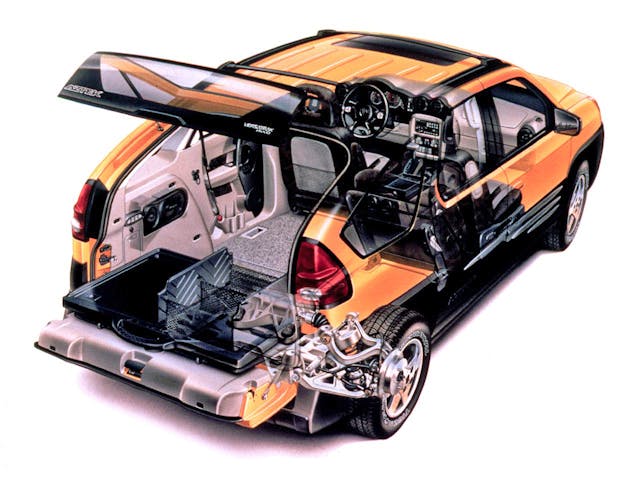
However, that minivan body meant removing seats was a breeze, and the (optional) sliding floor appearing from a tailgate/hatchback combination was perfect for grocery getting. The 2000s was the decade when the crossover-utility (CUV) began to assert its dominance, but most manufacturers did absolutely none of what Pontiac did for its customers. Even though the devil’s in the details (or lack thereof) the Pontiac Aztek coulda had class. It didn’t deserve this much hatred. As Terry Malloy in the movie Waterfront said: “I coulda been somebody, instead of a bum, which is what I am, let’s face it.”
2012–present Tesla Model S
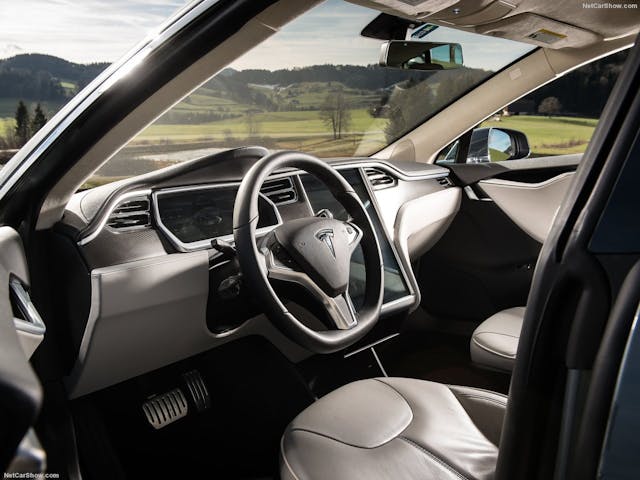
Love it or hate it, the first Tesla to garner substantial praise also had an interior that dictated the template for upmarket electric-vehicle cabins. Would you need an electric car with a gigantic screen if it weren’t for Tesla having the stones to choose a display that didn’t exist for automobiles yet that wasn’t designed for an automotive application? And who would have thought combining a column-shifted transmission, a console-free center stack, and an optional rear-facing third-row seat into a luxury car?
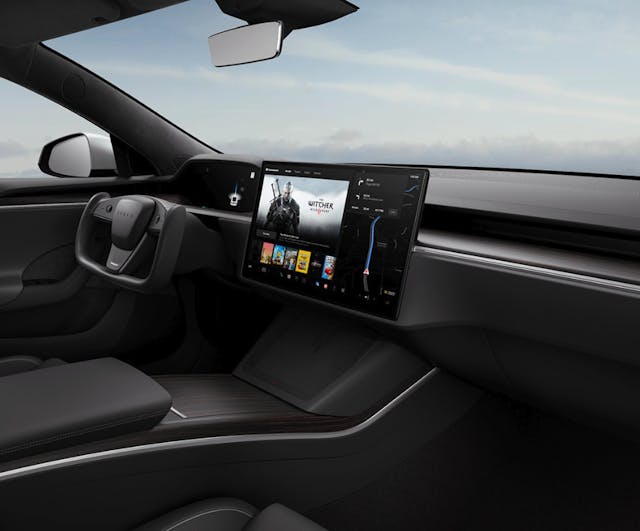
It all happened with one seminal vehicle, and the new steering yoke on the flagship Plaid model is merely testing the waters for the next revolution in automotive interior design. That said, the Model S is rather long in the tooth, and it wouldn’t hurt to give it a total redesign for the 2020s.
Which radical interiors over the decades would you add to this list? Let us know in the comments below.
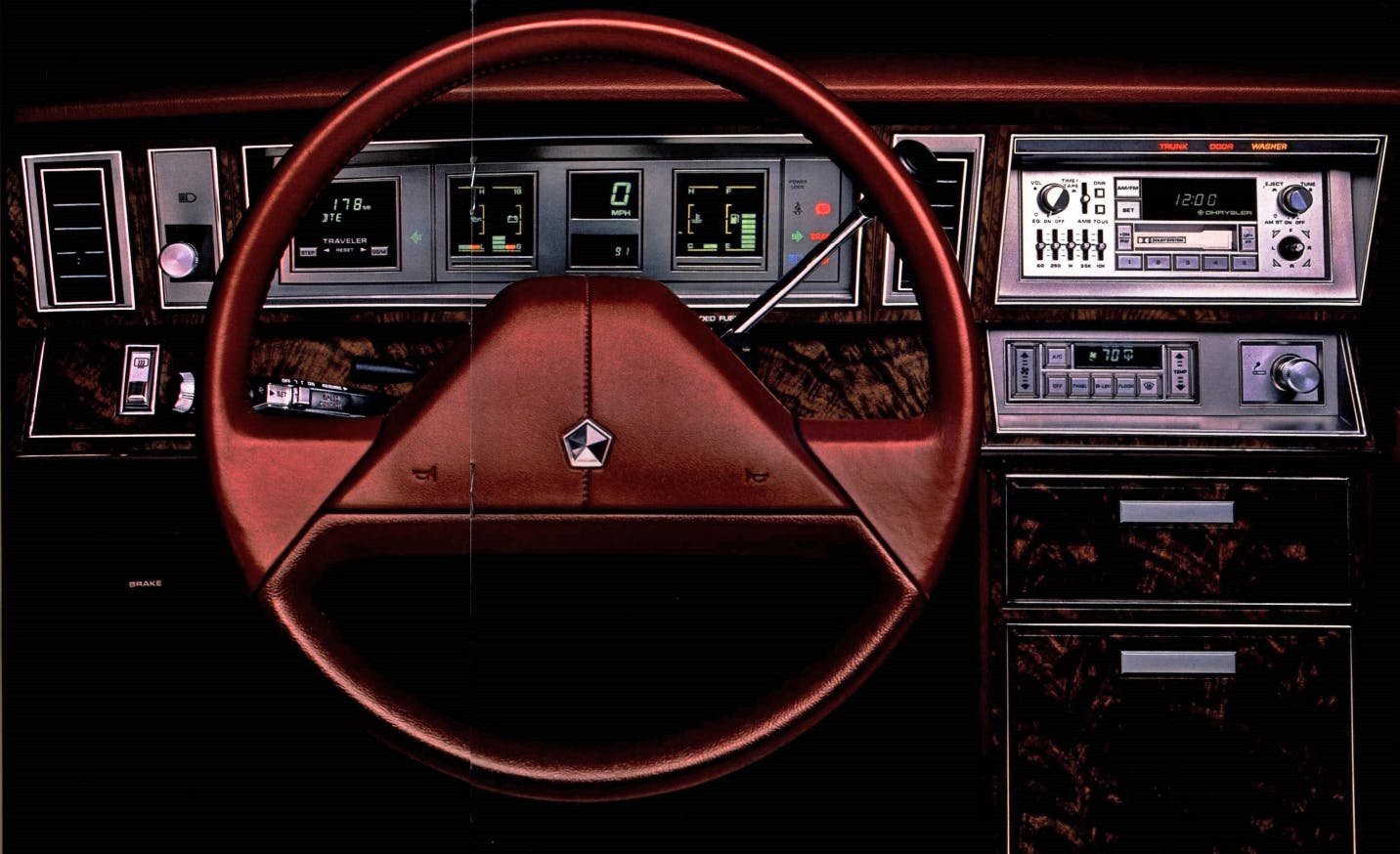
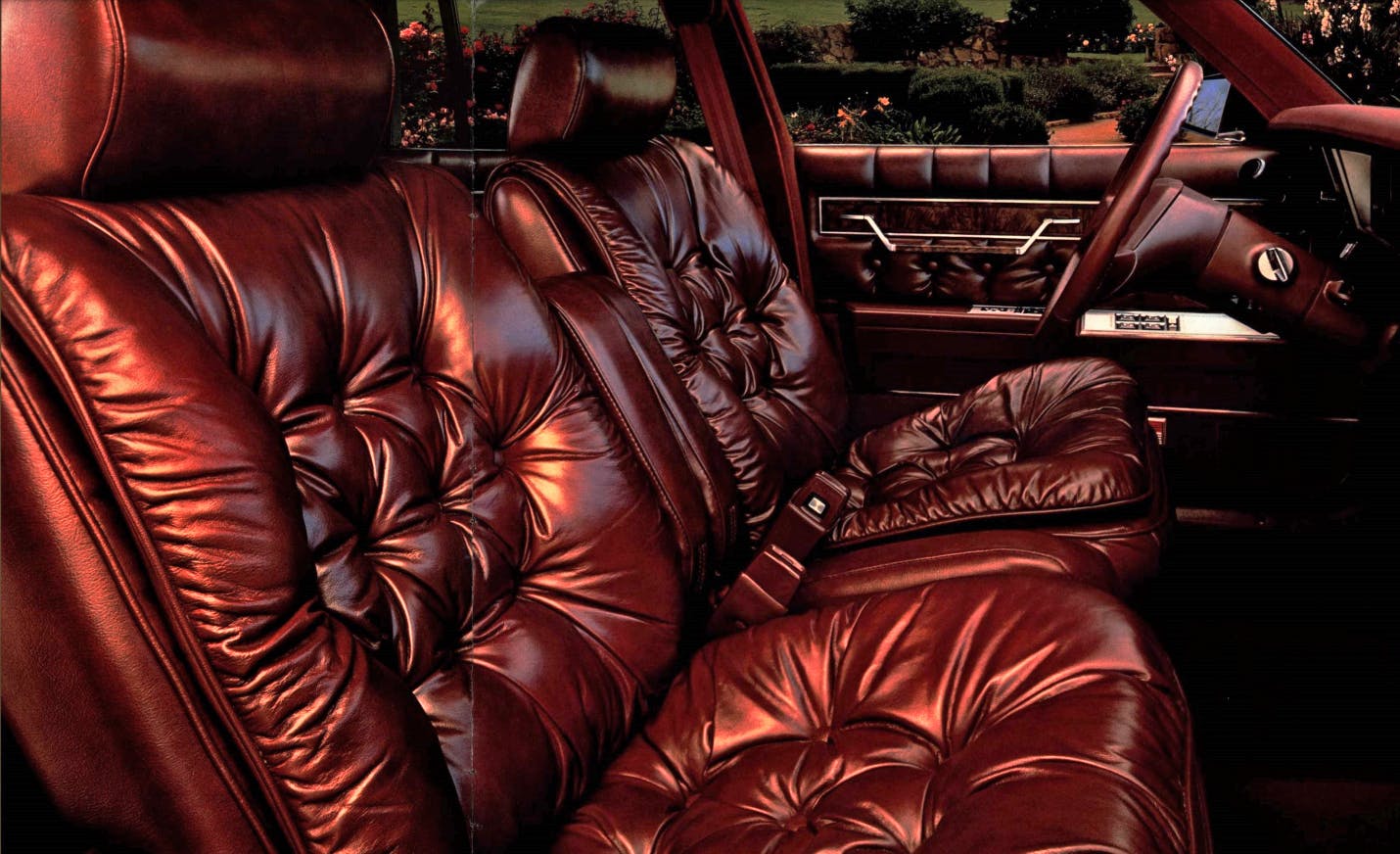


You left out the 1967 Ambassador. I have a picture. Brocade in a number of dif colours. How do I send you the pictures ?
I have so many favorites here are my top 5 dashboards of all time.
1, 1961 and 62 Chrysler’s Astrodome with Panelesent lighting.
2. This one made your list, 1964 to 1971 Thunderbirds
3, 1969 Mustang Mach I
4, 1976 Lincoln Town Car
5, 1967 Buick Riviera
Like I said, these are my top 5.but I have a lot more.